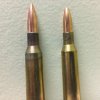I know a lot of people use bushings these days, but I was told that it isn't bad at all to go from a 30 cal to 7mm in one step with just a neck sizer also. I haven't decided what route I am going to go yet.
I was thinking about when I do my 7/300 brass the first time through, just taking the expander ball out of my full length 300 win die, so that when it takes down the neck, it won't re-expand it on the up stroke. Then when I go to the 7mm neck sizer, it wouldn't be as big of a step. Do my theories on this have any truth????? Be a little less work on the necks maybe? From what I understand, the dies compress the necks down smaller than needed, then the expander ball expands them to size. I am wondering how much a 300 win full length die will compress the neck I guess. MIght not be as good of idea as I thought.
I was thinking about when I do my 7/300 brass the first time through, just taking the expander ball out of my full length 300 win die, so that when it takes down the neck, it won't re-expand it on the up stroke. Then when I go to the 7mm neck sizer, it wouldn't be as big of a step. Do my theories on this have any truth????? Be a little less work on the necks maybe? From what I understand, the dies compress the necks down smaller than needed, then the expander ball expands them to size. I am wondering how much a 300 win full length die will compress the neck I guess. MIght not be as good of idea as I thought.

